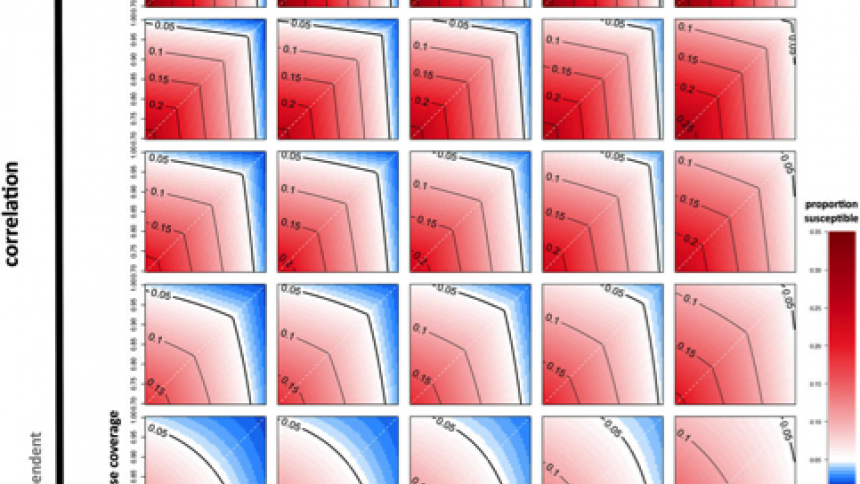Measles is a major cause of vaccine-preventable childhood death, and despite growing countrywide elimination, elimination maintenance and future elimination goals are constantly threatened by increased human travel, high transmissibility of the pathogen, and regionally poor vaccination coverage. Increased vaccination coverage is the leading practice to reduce and regionally eliminate measles; this is challenging because about 95% of the population must be immune (vaccinated) for effective herd immunity. CIDD researchers Amalie McKee, Matthew Ferrari, and Katriona Shea evaluated the effectiveness of current age-dependent, two-dose vaccination strategies and inform decision makers.
The measles vaccine is generally given in two doses, yet susceptibility can arise from ineffective vaccination, interactions between maternal antibodies and the vaccine, or not receiving either vaccine. In order to assess the efficacy of this practice, McKee, Ferrari, and Shea analyzed how the level of correlation between doses effects population immunity, where correlation is defined as the conditionality of receiving a second dose given that individual received a first dose (1=completely, 0=independent). They assess dose correlation over a range of realistic age structures.
McKee, Ferrari, and Shea found that reducing correlation between doses generally increases population immunity by increasing the proportion of the population that receives at least one dose. In fact, reducing correlation reduces the susceptible population regardless of the underlying population structure. However, reducing dose correlation also increases the rate of primary vaccine failure because fewer individuals receive a second dose; in the case of high vaccine efficacy, a second dose is less important and so a high correlation between doses becomes more trivial. A second dose administered independently of the first will have a large effect on population immunity, yet this effect will drastically decrease as correlation increases.
These results are extremely relevant as countries across the globe continue to work towards measles elimination yet are not equipped with all of the necessary information about differing vaccination strategies and implementation. For example, in four regions of the world, the decorrelation of first and second doses would affect population immunity more so than changes in age structure. Although there is a tradeoff between levels of vaccine dose correlation and population immunity/first dose failure rate, generally, reducing correlation is the best option for increasing vaccine coverage. For instance, it seems intuitive to improve coverage of the dose with lower coverage, but in settings where the doses are highly correlated, this will be disadvantageous compared to improving the higher coverage dose. Vaccine strategies that target groups with low vaccination coverage are most likely to advance the goal of measles elimination. Finally, this modeling approach is applicable to other types of infectious diseases and will help assess vaccine strategy tradeoffs and cost-benefits.
Synopsis written by Ellen Brandell
Figure caption: (Fig 2. from text) The susceptible proportion remaining for a range of first- and second-dose coverages, correlations and age structure parameters. The contours indicate various threshold levels of immunity, where <5% susceptible within the population is generally considered sufficient to maintain elimination and is coloured in blue. The white dashed line indicates where the coverage of each dose is equal.
Publication Details
Amalie McKee, Matthew Ferrari, Katriona Shea
Correlation between measles vaccine doses: implications for the maintenance of elimination
Journal: Epidemiology and Infection
McKee A, Ferrari MJ, Shea K. Correlation between measles vaccine doses: implications for the maintenance of elimination.
DOI Reference




